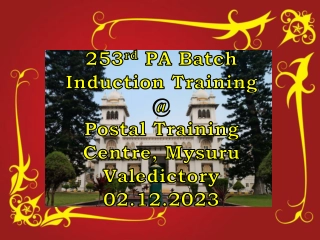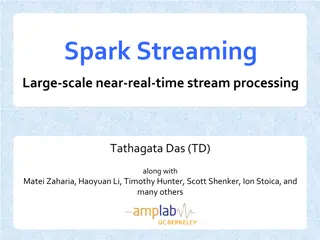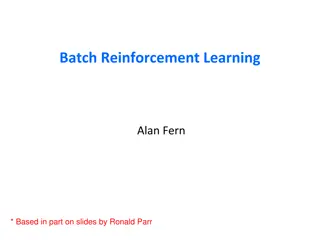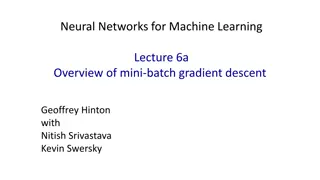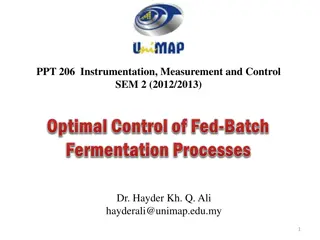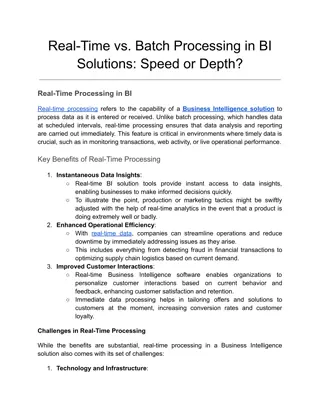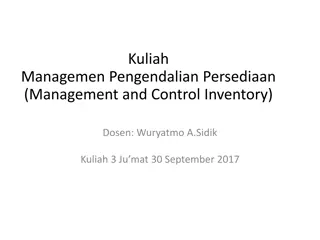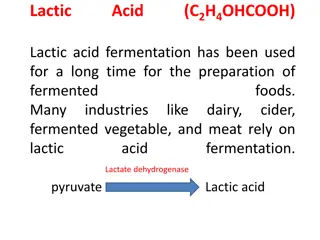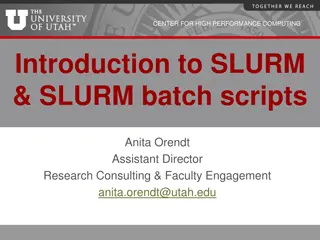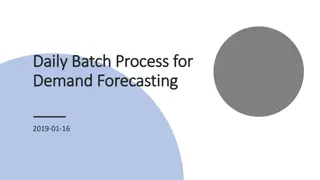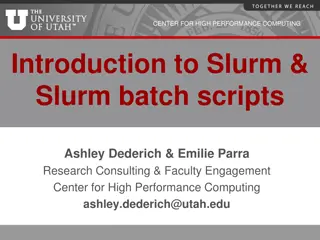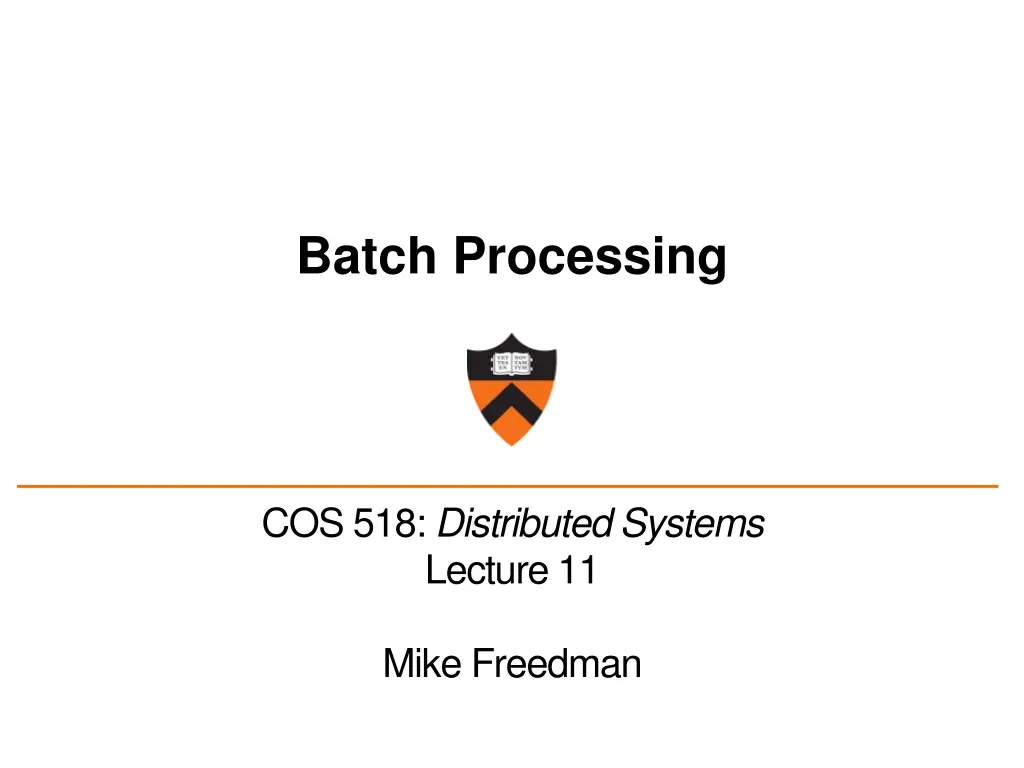
Distributed Systems Architecture in Big Data Processing
Explore the basic architecture of distributed systems in big data processing, including cluster management, worker setups, launching containers, and computing frameworks like YARN and Mesos with examples of Hadoop MapReduce and Spark.
Download Presentation

Please find below an Image/Link to download the presentation.
The content on the website is provided AS IS for your information and personal use only. It may not be sold, licensed, or shared on other websites without obtaining consent from the author. If you encounter any issues during the download, it is possible that the publisher has removed the file from their server.
You are allowed to download the files provided on this website for personal or commercial use, subject to the condition that they are used lawfully. All files are the property of their respective owners.
The content on the website is provided AS IS for your information and personal use only. It may not be sold, licensed, or shared on other websites without obtaining consent from the author.
E N D
Presentation Transcript
Batch Processing COS 518: Distributed Systems Lecture 11 Mike Freedman
Basic architecture in big data systems 2
Cluster Manager Worker Worker Worker Cluster
Cluster Manager 64GB RAM 32 cores Worker Worker 64GB RAM 32 cores 64GB RAM 32 cores Worker 64GB RAM 32 cores Cluster
Submit WordCount.java Cluster Manager Client Worker Worker Worker Cluster
Cluster Manager Client Launch executor Launch driver Worker Worker Launch executor Worker Cluster
Cluster Manager Client Word Count Word Count Worker driver Worker executor Word Count Worker executor Cluster
Cluster Manager Client Client Word Count Word Count Worker driver Worker executor Word Count Worker executor Cluster
Cluster Manager Client Launch executor Client Word Count Word Count Worker driver Worker executor Launch driver Word Count Worker executor Cluster
Cluster Manager Client Client Word Count Tweets Word Count Worker driver executor Worker executor Word Count Tweets Worker executor driver Cluster
Cluster Manager Client Client Word Count Tweets App3 Word Count App3 Worker driver executor executor Worker executor executor Client Word Count Tweets App3 Worker executor driver driver Cluster
Basic architecture Clients submit applications to the cluster manager Cluster manager assigns cluster resources to applications Each Worker launches containers for each application Driver containers run main method of user program Executor containers run actual computation Examples of cluster manager: YARN, Mesos Examples of computing frameworks: Hadoop MapReduce, Spark 12
Two levels of scheduling Cluster-level: Cluster manager assigns resources to applications Application-level: Driver assigns tasks to run on executors A task is a unit of execution that operates on one partition Some advantages: Applications need not be concerned with resource fairness Cluster manager need not be concerned with individual tasks Easy to implement priorities and preemption 13
Case Study: MapReduce (Data-parallel programming at scale) 14
Application: Word count Hello my love. I love you, my dear. Goodbye. hello: 1, my: 2, love: 2, i: 1, dear: 1, goodbye: 1 15
Application: Word count Locally: tokenize and put words in a hash map How do you parallelize this? Split document by half Build two hash maps, one for each half Merge the two hash maps (by key) 16
When in the Course of human events, it becomes necessary for one people to dissolve the political bands which have connected them with another, and to assume, among the Powers of the earth, the separate and equal station to which the Laws of Nature and of Nature's God entitle them, a decent respect to the opinions of mankind requires that they should declare the causes which impel them to the separation. Input document
When in the Course of human events, it becomes necessary for one people to dissolve the political bands which have connected them with another, and to assume, among the Powers of the earth, the separate and equal station to which the Laws of Nature and of Nature's God entitle them, a decent respect to the opinions of mankind requires that they should declare the causes which impel them to the separation. Partition
requires that they should declare the causes which impel them to the separation. When in the Course Nature and of Nature's of human events, it God entitle them, a becomes necessary for decent respect to the one people to opinions of mankind among the Powers dissolve the political of the earth, the bands which have separate and equal connected them with station to which another, and to assume, the Laws of
requires: 1, that: 1, they: 1, should: 1, declare: 1, the: 1, causes: 1, which: 1 ... when: 1, in: 1, nature: 2, and: 1, of: the: 1, course: 1, 2, god: 1, entitle: 1, of: 1, human: 1, them: 1, decent: 1, events: 1, it: 1 respect: 1, mankind: 1, opinion: 1 ... dissolve: 1, the: 2, among: 1, the: 2, political: 1, bands: powers: 1, of: 2, earth: 1, which: 1, have: 1, 1, separate: 1, equal: connected: 1, them: 1 1, and: 1 ... ... Compute word counts locally
requires: 1, that: 1, they: 1, should: 1, declare: 1, the: 1, causes: 1, which: 1 ... when: 1, in: 1, nature: 2, and: 1, of: the: 1, course: 1, 2, god: 1, entitle: 1, Now what of: 1, human: 1, them: 1, decent: 1, events: 1, it: 1 How to merge results? respect: 1, mankind: 1, opinion: 1 ... dissolve: 1, the: 2, among: 1, the: 2, political: 1, bands: powers: 1, of: 2, earth: 1, which: 1, have: 1, 1, separate: 1, equal: connected: 1, them: 1 1, and: 1 ... ... Compute word counts locally
Merging results computed locally Several options Don t merge requires additional computation for correct results Send everything to one node what if data is too big? Too slow Partition key space among nodes in cluster (e.g. [a-e], [f-j], [k-p] ...) 1. Assign a key space to each node 2. Partition local results by the key spaces 3. Fetch and merge results that correspond to the node s key space 23
requires: 1, that: 1, they: 1, should: 1, declare: 1, the: 1, causes: 1, which: 1 ... when: 1, in: 1, nature: 2, and: 1, of: the: 1, course: 1, 2, god: 1, entitle: 1, of: 1, human: 1, them: 1, decent: 1, events: 1, it: 1 respect: 1, mankind: 1, opinion: 1 ... dissolve: 1, the: 2, among: 1, the: 2, political: 1, bands: powers: 1, of: 2, earth: 1, which: 1, have: 1, 1, separate: 1, equal: connected: 1, them: 1 1, and: 1 ... ...
causes: 1, declare: 1, [a-e] requires: 1, should: 1, [f-j] that: 1, they: 1, the: [k-p] 1, when: 1, the: 1, [q-s] which: 1 nature: 2, of: 2, in: 1, it: 1, human: 1, [t-z] mankind: 1, opinion: 1, course: 1, events: 1, entitle: 1, and: 1, of: 1 decent: 1, god: 1, them: 1, respect: 1, among: 1, and: 1, bands: 1, dissolve: 1, connected: 1, have: 1, equal: 1, earth: 1, political: 1, the: 1, separate: 1, the: 2, them: 1, which: 1 powers: 1, of: 2 Split local results by key space
[q-s] [t-z] [f-j] [a-e] [k-p] All-to-all shuffle
[a-e] [f-j] when: 1, the: 1, requires: 1, should: [k-p] that: 1, they: 1, 1, respect: 1, [q-s] the: 1, which: 1, separate: 1 [t-z] them: 1, the: 2, god: 1, have: 1, the: 1, them: 1, in: 1, it: 1, which: 1 human: 1, bands: 1, dissolve: 1, connected: 1, course: 1, powers: 1, of: 2, events: 1, among: 1, and: 1, nature: 2, of: 2, equal: 1, earth: 1, entitle: 1, mankind: 1, of: 1, and: 1, decent: 1, causes: 1, opinion: 1, declare: 1 political: 1 Note the duplicates...
[a-e] [f-j] requires: 1, should: [k-p] 1, respect: 1, when: 1, the: 4, [q-s] separate: 1 that: 1, they: 1, [t-z] god: 1, have: 1, which: 2, them: 2 in: 1, it: 1, human: 1, bands: 1, dissolve: 1, connected: 1, course: 1, powers: 1, of: 5, events: 1, among: 1, and: 2, nature: 2, mankind: 1, equal: 1, earth: 1, opinion: 1, political: 1 entitle: 1, decent: 1, causes: 1, declare: 1 Merge results received from other nodes
MapReduce Partition dataset into many chunks Map stage: Each node processes one or more chunks locally Reduce stage: Each node fetches and merges partial results from all other nodes 29
MapReduce Interface map(key, value) -> list(<k , v >) Apply function to (key, value) pair Outputs set of intermediate pairs reduce(key, list<value>) -> <k , v > Applies aggregation function to values Outputs result 30
MapReduce: Word count map(key, value): // key = document name // value = document contents for each word w in value: emit (w, 1) reduce(key, values): // key = the word // values = number of occurrences of that word count = sum(values) emit (key, count) 31
MapReduce: Word count map combine partition reduce 32
MapReduce 2011 2012 2015 2004 2007 Dryad
Brainstorm: Top K Find the largest K values from a set of numbers How would you express this as a distributed application? In particular, what would map and reduce phases look like? Hint: use a heap 35
Brainstorm: Top K Assuming that a set of K integers fit in memory Key idea... Map phase: everyone maintains a heap of K elements Reduce phase: merge the heaps until you re left with one 36
Brainstorm: Top K Problem: What are the keys and values here? No notion of key here, just assign the same key to all the values (e.g. key = 1) Map task 1: [10, 5, 3, 700, 18, 4] (1, heap(700, 18, 10)) Map task 2: [16, 4, 523, 100, 88] (1, heap(523, 100, 88)) Map task 3: [3, 3, 3, 3, 300, 3] (1, heap(300, 3, 3)) Map task 4: [8, 15, 20015, 89] (1, heap(20015, 89, 15)) Then all the heaps will go to a single reducer responsible for the key 1 This works, but clearly not scalable 37
Brainstorm: Top K Idea: Use X different keys to balance load (e.g. X = 2 here) Map task 1: [10, 5, 3, 700, 18, 4] (1, heap(700, 18, 10)) Map task 2: [16, 4, 523, 100, 88] (1, heap(523, 100, 88)) Map task 3: [3, 3, 3, 3, 300, 3] (2, heap(300, 3, 3)) Map task 4: [8, 15, 20015, 89] (2, heap(20015, 89, 15)) Then all the heaps will (hopefully) go to X different reducers Rinse and repeat (what s the runtime complexity?) 38
Monday 3/25 Stream processing 39
Application: Word Count SELECT count(word) FROM data GROUP BY word cat data.txt | tr -s '[[:punct:][:space:]]' '\n' | sort | uniq -c 40
Using partial aggregation 1. Compute word counts from individual files 2. Then merge intermediate output 3. Compute word count on merged outputs 41
Using partial aggregation 1. In parallel, send to worker: Compute word counts from individual files Collect result, wait until all finished 2. Then merge intermediate output 3. Compute word count on merged intermediates 42
MapReduce: Programming Interface map(key, value) -> list(<k , v >) Apply function to (key, value) pair and produces set of intermediate pairs reduce(key, list<value>) -> <k , v > Applies aggregation function to values Outputs result 43
MapReduce: Programming Interface map(key, value): for each word w in value: EmitIntermediate(w, "1"); reduce(key, list(values): int result = 0; for each v in values: result += ParseInt(v); Emit(AsString(result)); 44
MapReduce: Optimizations combine(list<key, value>) -> list<k,v> Perform partial aggregation on mapper node: <the, 1>, <the, 1>, <the, 1> <the, 3> reduce() should be commutative and associative partition(key, int) -> int Need to aggregate intermediate vals with same key Given n partitions, map key to partition 0 i < n Typically via hash(key) mod n 45
Fault Tolerance in MapReduce Map worker writes intermediate output to local disk, separated by partitioning. Once completed, tells master node. Reduce worker told of location of map task outputs, pulls their partition s data from each mapper, execute function across data Note: All-to-all shuffle b/w mappers and reducers Written to disk ( materialized ) b/w each stage 46
Fault Tolerance in MapReduce Master node monitors state of system If master failures, job aborts and client notified Map worker failure Both in-progress/completed tasks marked as idle Reduce workers notified when map task is re-executed on another map worker Reducer worker failure In-progress tasks are reset to idle (and re-executed) Completed tasks had been written to global file system 47
Straggler Mitigation in MapReduce Tail latency means some workers finish late For slow map tasks, execute in parallel on second map worker as backup , race to complete task 48


